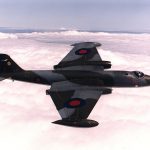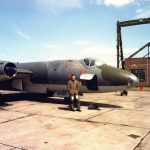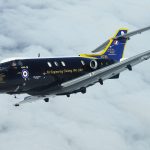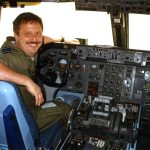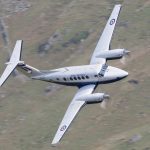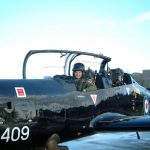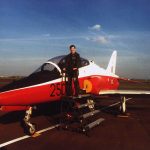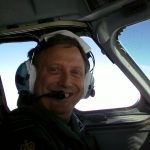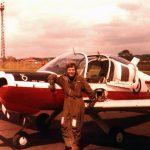Managing an Engine Failure After Take-Off (EFATO)
There is no point in performing the perfect engine failure drill if, while doing so, you lose control of the aircraft and fly into the ground! So the first priority must always be to FLY THE AIRCRAFT.
Fly the Aircraft
To do this you must level the wings and apply rudder to stop the yaw. Doing so will also allow you to quickly and reliably identify which engine has lost power by using the “Dead leg – Dead engine” technique.
If speed is decreasing rapidly and looks set to drop below 88kts, then the pitch attitude should be reduced to maintain it. Remember that at 88kts with the aircraft clean, you need a pitch attitude of about 5° just to stay level, so do not lower the nose too much and risk descending rapidly into the ground. During a normal take-off, you usually select about 10° of pitch as you rotate, then lower the nose to about 7° of pitch once the gear and flaps have retracted and you accelerate to establish a climb at 110kts. So if you suffer an engine failure at any point in that process, lowering the pitch attitude to 5° will arrest your speed decay and buy you time without putting you into a descent. If you have already achieved 110kts in the climb when the engine fails, it is entirely possible to complete the engine failure drill without significantly lowering the nose – but you have to act quickly to do so.
Select Full Power
If you lose engine thrust in the climb then, whilst “flying the aircraft”, your next instinctive reaction should be to select full power to help you maintain a positive rate of climb.
Real Engine Failure. Leaving simulated EFATOs aside for now, after a real loss of thrust, you will probably be quite surprised and startled and this may delay you taking action. However, it does not take much thought to immediately select both Mixture levers to full rich, Prop levers to maximum RPM and Throttles to maximum – doing so would be unlikely to cause additional damage to the failed engine, but it would make identification of the failed engine more obvious due to the greater rudder force needed to stop the yaw. Notice that your hand needs to move from right-to-left when selecting full power.
Simulated Engine Failure. When simulating an EFATO, examiners will usually do so by obscuring your view of the throttles while retarding one of them, then expect you to identify which engine has “failed” before uncovering the throttles and allowing you to select full power on the “live” engine. So as the examiner simulates the engine failure, make sure to use the rudder to keep the aircraft in balance and promptly use the “Dead leg – Dead engine” technique to identify the “failed” engine. Then, once the throttles are uncovered, promptly move your hand from right-to-left, selecting both Mixture levers to full rich, both Prop levers to maximum RPM and only the “live” engine Throttle to maximum.
Remove the Drag
Your next priority is to reduce drag on the aircraft. It takes only a couple of seconds to select Flaps UP and Gear UP, so do that without delay!
After an engine failure, the propeller on the failed engine will probably continue to spin by taking energy from the airflow to keep it turning (windmilling) and create lots of drag in the process. So the propeller on the failed engine must now be feathered without delay.
Real Engine Failure. When feathering an engine, the throttle must be selected to idle first – if when doing that, you completely lose engine thrust, you’ll know that you’ve misidentified the failed engine and can quickly restore it to full thrust. Next, move the failed engine’s Prop lever promptly to the “Feather” position (fully rearwards through the gate) – if it is moved too slowly and the RPM is allowed to drop below 800 RPM before the “Feather” position is reached, the propeller will not feather! Finally, select the Mixture lever to cut-off. Notice that your hand movement is from left-to-right, the opposite to selecting full thrust; it is important to do it in that order to ensure that the propeller feathers correctly.
Simulated Engine Failure. If the examiner is simulating an EFATO, you must carry out a “touch drill” feathering of the propeller by first touching the failed engine’s Throttle and announcing “L/R Throttle closed”, then touching the failed engine’s Prop lever and announcing “L/R Prop Feather”, finally touching the failed engine’s Mixture lever and announcing “L/R Mixture Cut-off”. At that point the examiner will increase the thrust on the “failed” engine to approximately 15” MAP to simulate that the propeller has been feathered.
Finally, to remove all unnecessary drag, ensure that the failed engine’s cowl flap is closed.
Fly the Aircraft.
Once full power is applied and excess drag removed, the “immediate actions” are complete. So there is now time to relax, take a deep breath and settle down to concentrate on accurate flying and trimming the aircraft.
The act of feathering the failed engine will reduce the drag quite noticeably and change the trim forces, so it will now be very important to fly the aircraft and establish a stable climb at Vyse. It will be necessary to re-adjust the rudder pressure to stop any yaw and to select approximately 7° of pitch to maintain the IAS at Vyse. As the situation is now well under control, you can now, and must, take the time to trim the rudder and stabilizer whilst regaining any required heading.
Common Errors. As mentioned earlier, it is entirely possible to have an engine fail at 110 kts with 7° of pitch set, promptly carry out the EFATO drill and establish a climb at Vyse without having to lower the pitch attitude, but it requires practice and lots of rehearsal to do so. Most students are indecisive and uncertain to begin with and many of them delay feathering the engine therefore letting the speed drop too much. This necessitates lowering the nose to maintain speed, changing rudder settings and maybe having to roll to keep wings level, all of which delays feathering the failed engine so the situation becomes progressively worse. The message is clear – learn the drill, practice it, and rehearse it by saying the words out loud. The slicker you get at doing it, the more confident you will become and the easier you will find it.
Securing the Engine.
Once you’ve trimmed the aircraft into a safe climb at Vyse, you can now make the engine safe. If it was a simulated engine failure, make sure you use “touch” drills or you’ll spoil everyone’s day!
Move your right hand rearwards from the trim wheels and select the failed engine’s Fuel Select lever to OFF (the centre position).
Next, move your hand vertically upwards towards the battery master switch then, moving towards the failed engine, select the failed engine’s Alternator switch OFF (although this action is not included in the SOPs and QRH, it is a mandatory action in the POH). Then, using only your index finger, move one switch at a time towards the failed engine, switching off the appropriate Fuel Pump and Magneto switches. Finally, keep moving your eyes towards the failed engine and look to see if there are any signs of a fire.
Engine Fire?
It is very unlikely that the examiner will simulate an engine fire on an IRT, but it is important you know what to do it if happens for real.
The Engine Fire checklist is essentially the same as the drill that you have just completed, however, if you now notice that the engine is on fire, select the Cabin Heat and Defrost switches OFF, open the Cowl Flap on the engine which is on fire and monitor the situation. If the fire does not go out, increase your airspeed to try to blow out the fire – and to get back onto the ground as quickly as possible. Good luck!
Emergency call.
For a straightforward loss of power and engine shutdown, the emergency RT call would probably be a PAN, but if you just noticed signs of fire or structural damage, it should be a MAYDAY.
If the examiner is simulating an EFATO, he/she will usually want you to make the call to him/her rather than making a practice PAN call, but listen carefully to the pre-flight briefing.
Preserving the Live Engine.
Finally, as the one remaining engine is working hard, it is very important to ensure that it, and its systems, are managed carefully.
Ensure that the Prop Sync switch is off, then select the MFD to the Engine page and check the electrical load. The maximum load permissible on one alternator is 85 amps, so you may have to load-shed if necessary.
Check the CHTs, although they are unlikely to be high in the UK climate, the Cowl Flap on the live engine should be half opened and remain in that position until after landing.
Also check the vacuum pressure to ensure that surface de-icing is still available. However, with one engine inoperative, exit and avoid icing conditions if possible.
Routinely check the fuel balance and use the X-Feed setting on the live engine fuel selector when necessary to avoid an excessive fuel imbalance.

